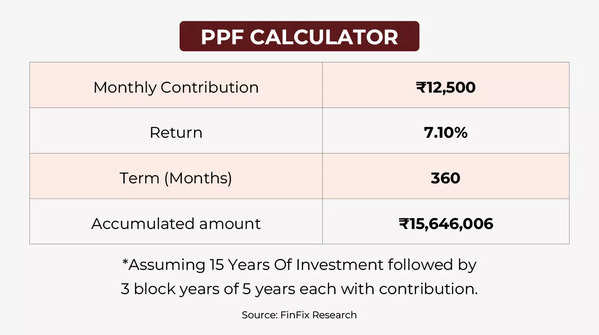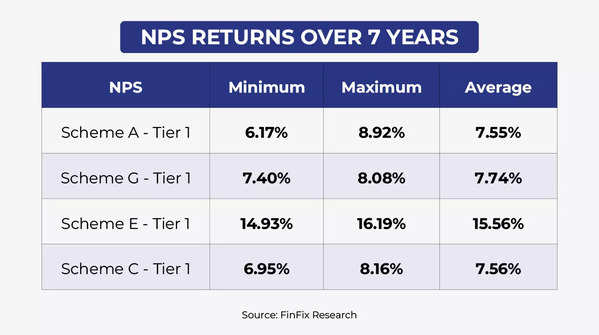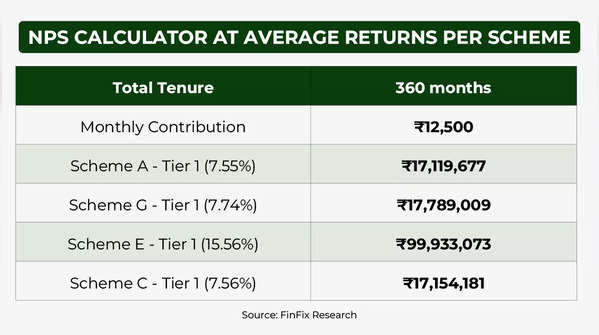TOI Business Desk
/ TIMESOFINDIA.COM / Updated: 07 Jul 2024, 10:42:34 PM
AA
Text Size
- Small
- Medium
- Large

1/10
NPS vs PPF Calculator: Is NPS Better Than PPF To Become A Crorepati?
NPS vs PPF Calculator: Which is a better investment bet for retirement planning – National Pension System or Public Provident Fund? If accumulating a corpus of over Rs 1 crore is your aim, then both NPS and PPF are seen to be good investments, but which one should you pick? What are the minimum and maximum investment limits for NPS and PPF and what are returns? How do the tax benefits of NPS and PPF compare? We take a look at some PPF and NPS calculations, average returns and other important aspects to compare the two schemes: (AI image)

2/10
NPS vs PPF: Minimum & Maximum Investment Amount
NPS vs PPF: In NPS the minimum annual investment is Rs 6,000, while there is no upper limit on investments. On the other hand for PPF accounts, the minimum annual investment is Rs 500 and the maximum you can invest in a year is Rs 1.5 lakh. (AI image)

3/10
PPF Calculator
Public Provident Fund Calculator: Assuming that a person starts investing in PPF at the age of 30 and continues to do so till the age of 60, that is for a period of 30 years (15 years minimum lock in plus 3 block extensions of 5 years) or 360 months, then a monthly contribution of Rs 12,500 or an annual contribution of Rs 1.5 lakh with an interest rate of 7.1% will result in a corpus of over Rs 1.5 crore. (AI image)

4/10
NPS Average Returns
National Pension System Returns: There are four Asset Classes – Asset class E – Equity and related instruments, Asset class C – Corporate debt and related instruments, Asset class G – Government Bonds and related instruments and Asset Class A – Alternative Investment Funds including instruments like CMBS, MBS, REITS, AIFs, Invlts etc. Here we are looking at the average returns over 7 years from Scheme A, Scheme G, Scheme E and Scheme C, as provided by FinFix Research. The average return from Scheme A is at 7.55%, for Scheme G is 7.74%, for Scheme E is 15.56% and for Scheme C it stands at 7.56%. (AI image)

5/10
NPS Calculator
National Pension System Calculator: According to FinFix Research, with a monthly contribution of Rs 12,500/- or an annual contribution of Rs 1.5 lakh, over a period of 30 years you will get a corpus of over 1.7 crore from Scheme A, Scheme G and Scheme C. However, if you are not risk averse and invest in Scheme E, you will get over Rs 9.9 crore at the average return of 15.56%. It’s important to remember that these calculations are based on average returns over a 7 year period. With a 30 year time horizon for investment in mind, the returns are bound to differ. (AI image)

6/10
NPS vs PPF Tax Benefits
NPS vs PPF tax benefits: The maximum amount of yearly investment in PPF, that is Rs 1.5 lakh, is exempt from tax under Section 80C. Additionally, PPF is a EEE product, which means that the interest earned and the maturity proceeds are fully tax exempt. In case of NPS, tax exemptions up to Rs 2 lakh (1.5 lakh + Rs 50,000) are available. At the time of maturity, 60% of total corpus is tax exempt, the remaining 40% invested in annuity is also exempt, but income earned from the annuity is taxable depending on your tax slab. (AI image)

7/10
NPS vs PPF: Liquidity
NPS Vs PPF: The liquidity in both NPS and PPF is low because both have a long lock-in period. While PPF is a risk-free option with its sovereign guarantee, NPS risks depend on the scheme you pick, with the equity option being higher risk. (AI image)

8/10
NPS vs PPF: Eligibility & Freedom of Investment
NPS vs PPF: An Indian citizen in the age group of 18 to 70 years can open an NPS account, whereas any citizen above 18 years can open a PPF account. However while NRIs can open NPS accounts, they can’t opt for PPF. In NPS, you can choose the investment portfolio. Such freedom of investment doesn’t exist in PPF. (AI image)

9/10
NPS vs PPF: Which Is A Better Investment?
NPS vs PPF: Considering the differences between PPF and NPS, both offer attractive features for retirement planning. PPF is a suitable choice for long-term investors looking for predictable and steady returns. Conversely, NPS provides the opportunity to customize asset allocation and invest in higher-risk assets for potential long-term wealth creation. According to FinFix Research, if one were to look at the 7 year returns of Scheme A, G, C and E, then between PPF and NPS, Public Provident Fund may be a slightly better investment bet considering that there is no mandate to invest 40% corpus in an annuity plan. However, if you are willing to opt for the riskier Scheme E, then the average returns of anywhere between 10-15% would make NPS a far better investment option compared to PPF. (AI image)

10/10
NPS vs PPF: Risk Appetite
NPS vs PPF: Financial experts say that choice between NPS and PPF depends on an individual’s preferences, needs, and convenience. PPF is ideal for those who are risk-averse, while NPS may appeal to those willing to accept higher risk for potentially higher returns. (AI image)
FOLLOW US ON SOCIAL MEDIA

